
1A TO i
51 11 00.39 N 1 46 48.69 W


The students now recalculate their position and traipse 1080-feet westwards @ 250.4-degrees (70.4-degrees return).
Upon arrival at the new objective the tutorial related to the distance and angle numbers is contained within the following mathematical progression:
1080, 2160, 3240, 4320, 5400, 6480, 7560, 8640, 9720, 10800, 11880, 12960, 14040, 15120, 16200, 17280, 19440, 20250, 21600, 22680, 23760, ... 25920 ... 29160, 30240 ...34560 ... 45360 ... 51840 ... 130680000.
This progression relates to both navigation and the Precession of the Equinoxes. The sun spends 2160-years in each of the Houses of the Zodiac during the 25920-year (72 X 360) cycle of Precession. This means we have to change our calendar date for the equinox event 1-day every 72-years to keep in line with the actual vernal equinox day. The ancient Sumerian/Babylonian Homer volume was 21600 cubic inches, the old English Bushel was 1/10th of that @ 2160 cubic inches, the diameter of the moon is 2160 English miles, whereas the diameter of the sun is essentially 864,000-miles.
In our ages-old Sumerian compass system there are 60-seconds, 60-minutes & 360-degrees, totaling 1296000-seconds of arc. The sum of 12960-years would be the half cycle of the Precession of the Equinoxes. A cubic foot is 12 X 12 X 12 cubic inches or 1728 cu". Values like 756, 1512, 2268 and 3024 describe 1/4, 1/2, 3/4 or a full circumnavigation of the Great Pyramid's base and 3024-feet was 1/2 of 1-minute of equatorial arc.
The progression advances to finally generate the value 130680000' (the equatorial circumference of the Earth under the 5280' mile system).
The merits of distances of 1036.8, 1050' and 1056' would also be elaborated upon as close proximity distance codes. Also the return angle of 70.875-degrees. A string based upon 10368 goes:
10368, 20736, 31104, 41472, 51840, 62208, 72576, 82944, 93312, 103680, 114048, 124416, etc. The progression advances to produce 24883.2 which, in miles, was the 12 X 12 X 12 X 12 X 1.2 equatorial circumference of the Earth.
In the above line-up, the value 1036.8 (1/24th of 24883.2) tells us how fast the Earth rotates in miles per hour (mph). The largest Egyptian Royal cubit was 20.736", the sum of 3110.4-miles would be 1/8th of the equatorial circumference, whereas 12441.6-miles would be 1/2. The value 933120 grains was very important to the Sumerians/Babylonians, as their Talent weight standard.
The return angle (180-degrees opposed) for this journey between shafts is 70.4-degrees and this is a value related to the mile of 5280-feet and also the equatorial circumference under the 24750 reading.. The mathematical progression for this goes:
70.4, 140.8, 211.2, 281.6, 352, 422.4, 492.8, 563.2, 633.6, 704, 774.4, 844.8, 915.2, 985.6, 1056 ... 5280 ... 130680000.
The sum of 70.4-feet is 1/75th of 5280-feet and 352-feet is 1/15th. The sum of 1056-feet is 1/5th of a mile and each of the above values are fractions of either the English mile of 5280-feet, the Scottish mile of 5940-feet or the league of 16500-feet (3.125-miles).
The progression advances to finally generate the value 130680000' (the equatorial circumference of the Earth in feet under the 5280' mile system).
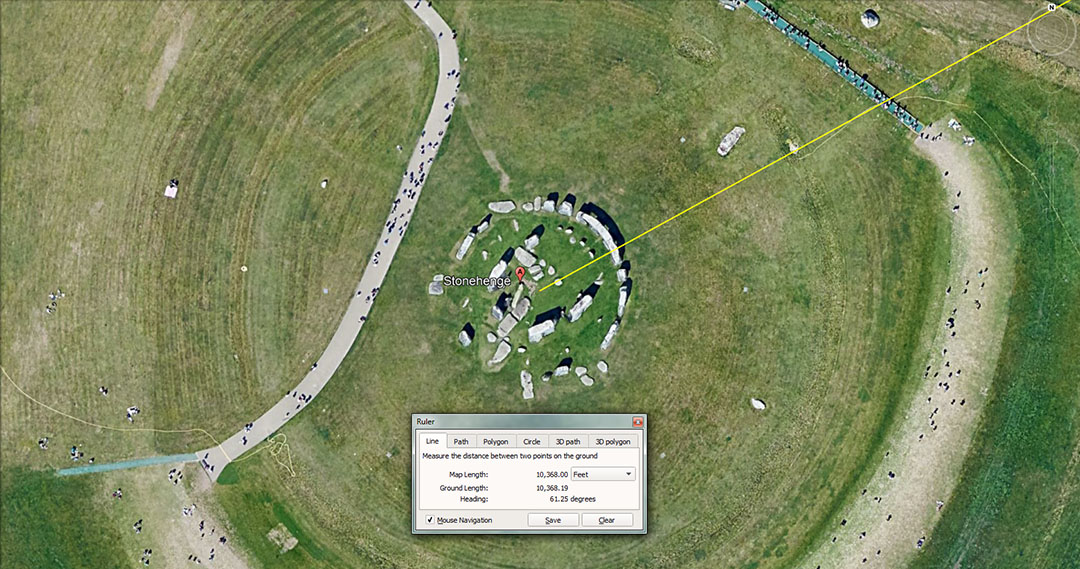
The distance from the centre of Durrington walls Henge to the centre of Stonehenge is 10368-feet, encoding the value for the speed of rotation of the Earth in miles per hour. Therefore, 24883.2-miles ÷ 24 hours = 1036.8 mph.
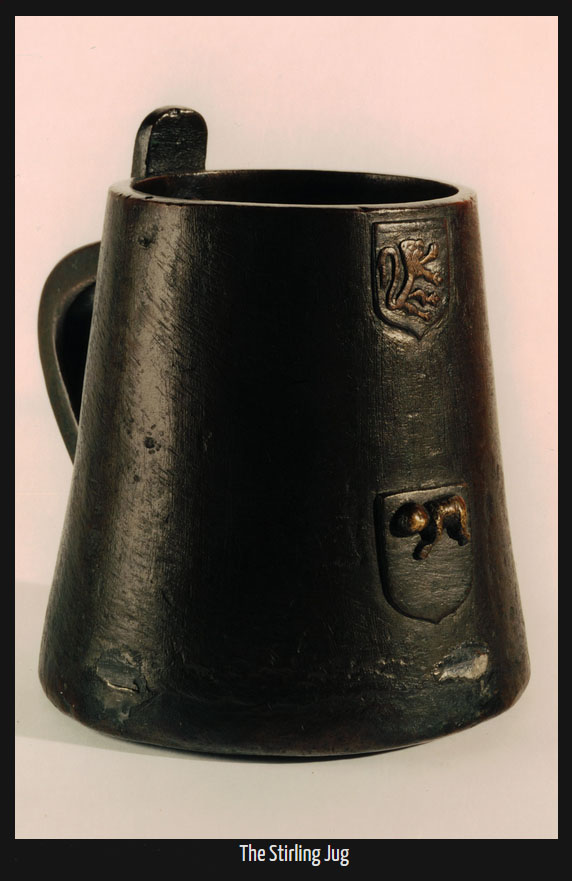
'The Stirling Jug, Pint or Stoup was the official Pint measure for Scotland from the early 16th century until the Union in 1707. It is 103.7 cubic inches or approximately 3 and a quarter imperial pints. The Stirling pint was the standard for all volume measures including the dry goods measures for grain. The pint is thought to have been made in 1513 at Edinburgh Castle by Robert Borthwick (the King's Master Gun Maker). The technology for making such an accurate measure was not available until that time. The image on the front of the jug is thought to be a pascal lamb, which was not acceptable after the reformation, and in later versions this was changed to a wolf - the symbol of Stirling. Transferred to The Smith Museum in 1897'.
Under the ancient Jerusalem standard for liquid volume capacities (wine, olive oil, etc.) 1 Cab volume was 103.68 cubic inches. This was also the cubic capacity of the old, Scottish Stirling jug, used for dispensing standard quantities of ale. The pascal lamb image (lamb sacrificed at the Feast of the Passover by the Hebrews before the Babylonian conquest of circa 600 BC) on the Stirling Jug also infers a pedigree back to the ancient Hebrew Cab volume.
A mathematical progression based upon 1050 goes:
1050, 2100, 3150, 4200, 5250, 6300, 7350, 8400, 9450, 10500, 11550, 12600, 13650, 14700, 15750, 16800, 17850, 18900, 19950, 21000, etc. The progression goes on to generate 2551.5, 2835, 5250, 6300, etc.
This value, as 10.5' or 126" was the Hebrew Reed, as well as a reed equivalent increment used under the measurement system adopted by the Greeks, with their foot being of 12.6" (1/10th of a reed).
The value 2551.5 in days would equate to 7.2 lunar years and this value was essential to tracking the moon during 7-solar years (2556.75-days) under the lunisolar Sabbatical Calendar system. The increment 5.25-feet (half a Hebrew Reed of 10.5-feet would have been very useful for mnemonic reference to this and it's highly probable that the forebears of the Druids had calibrated staffs that were 5.25-feet long. Thus 5.25-days X 486 = 2551.5 and 5.25-days X 487 = 2556.75-days.
The 2835 figure represents the perimeter total, in feet, for a full circumnavigation of the Khafre Pyramid of Egypt (a pyramid of the moon), conceived and built to be 708.75' per side or 15/16th the side length of the Great Pyramid (756-feet). Half of 708.75 is 354.375 and that just happens to be, in days, the length of a lunar year to a very close tolerance of under 12-minutes. The 354.375 value is encoded many times between shaft positions situated out from Durrington Walls Henge.
The 5250 figure is the Greek mile and 6300' would be 10 Greek long stadia or stadiums. The sprint event, over 1-stadia of 630-feet, was the most prestigious of the Greek Olympics.
A mathematical progression based upon 1056 goes:
1056, 2112, 3168, 4224, 5280, 6336, 7392, 8448, 9504, 10560, 11616, 12672, 13728, 14784, 15840, etc. The progression would generate a raft of important values like 2640, 6336, 7920, etc., all the way to the equatorial circumference of the Earth in feet. The sum of 1056' would be 1/5th of a mile of 5280-feet and 1584-miles would be 1/5th of the Earth's diameter (7920-miles).
The progression advances to finally generate the value 130680000' (the equatorial circumference of the Earth under the 5280' mile system).
i TO 2A
51 10 56.86 N 1 47 04.60 W

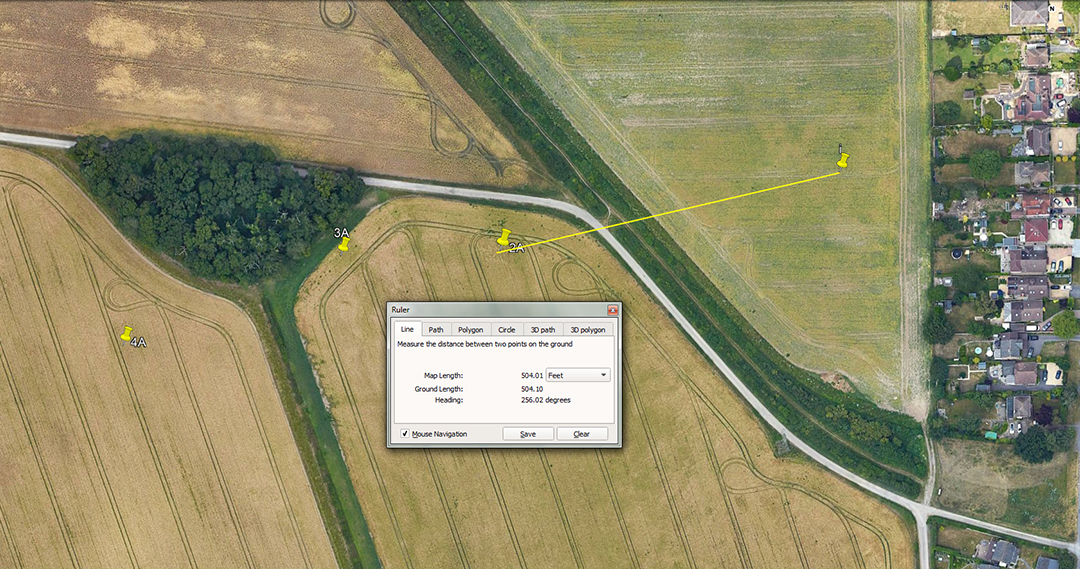
The students recalibrate their surveying instruments in order to head off for 504-feet @ 256-degrees.
Also, the merits of 518.4' would be elaborated upon, as well as a return angle of 76.8-degrees.
A mathematical progression based upon 504 goes:
504, 1008, 1512, 2016, 2520, 3024, 3528, 4032, 4536, 5040, 5544, 6048, 6552, 7056, 7560, 8064, 8568, 9072, ... 10080 ... 12096 ... 12600 ... 13608 ... 22680 ... 27216 ... etc.
The sum of 100.8-feet was 1-second of arc for the equatorial circumference of the Earth under the Great Pyramid's literal navigational system. The Great Pyramid was 756-feet long, which was 100.8 feet X 7.5. By making one full circumnavigation of the Great Pyramid, one had traveled 3024-feet or 1/2 of 1-minute of equatorial arc. Two circumnavigations was, of course, 1-minute of arc or 6048-feet and this value X 60 gave 1-degree of arc for the world's equator (6048 X 60 = 362880-feet or 69.12 of the "mile" adopted by the Greeks (with a length of 5250-feet each or 5000 Greek feet of 12.6-inches).
Also, in all history, the Great Pyramid has never been seen to have a pointed capstone on top, but has always been a truncated pyramid. The flat altar floor on top sits at 453.6-feet or 4.5 seconds of arc vertical height. The 756-feet length of the Great Pyramid is also 9072-inches or 453.6-inches X 2 and that equates to 264 of the shortest of the Egyptian Royal cubits @ 20.61818182-inches (20 & 34/55ths).
The formula for calculating the length of this cubit is 756-feet (9072-inches) ÷ by 440 = 20.61818182-inches. As stated, this length X 1200 (with the result read as miles) represented the Earth's equatorial circumference under the Great Pyramid's navigational system. The value arrived at was either 24741 & 8/11ths English miles of 5280-feet or 24883.2 Greek miles of 5250-feet.
The degree angle from station "i" to station 2A is 256-degrees and a mathematical progression based upon this goes:
256, 512, 768, 1024, 1280, 1536, 1792, 2048, 2304, 2560, 2816, 3072, 3328, 3584, 3840, 4096, 4352, 4608 ... 5888 ... 6400 ... 6912 ... 9216 ... 11520 ... 13824 ... etc.
Again, this string is navigational coding using the 130636800-feet equatorial circumference (24883.2 Greek miles of 5250-feet each). For example, 130636800-feet ÷ 13824 = 9450-feet. Alternatively, the value 24883.2-miles (either Greek or English) ÷ 13824 = 1.8 -miles. The string was simply another means of calculating divisions within the equatorial circumference.
The values, 2304, 4608, and 11520 are part of the 11.52 progression that was important to the Stonehenge outer rim, coded measurement of the Sarsen Circle (11.52-feet X 30-lintels = 345.6-feet). As stated, 345.6-miles would equate to 1/72nd of the 24883.2-mile equatorial circumference of the Earth.
By adding another 14.4-feet to the 504-feet reading between shafts, the distance would be the close proximity value of 518.4-feet and its merits could be elucidated upon by the tutor at the same shaft station. A progression based upon 518.4 would go:
518.4, 1036.8, 15552, 2073.6, 2592, 3110.4, 3628.8, 4147.2, 4665.6, 5184 ... 6220.8 ... 7776 ... 9331.2 ... 12441.6 ... 24883.2.
The value 51.84 is one of the most important and prominent of antiquity, used in navigational computations, as well as divisions within the Precession of the Equinoxes duration (25920-years ÷ 5 = 5184).
It is also the slope angle of the Great Pyramid of Egypt (51.84-degrees) and features in computing the area of terrain covered by the Great Pyramid's base, which is 72 X 72 reeds of 10.5-feet each = 5184 square reeds.
One of 5 renditions of PI (3.1416 to 1) used in ancient computation for full figure readings of a circumference was 1728/550ths. Others were 22/7ths, 3.125 or 3.15. The value chosen depended on what number family or combined families one wished to use when rendering a diameter into a circumference. When turning an "11" family of numbers into a circumference, such as the league of 16500-feet (3.125-miles of 5280-feet each) the formula was 16500-feet X 1728/550ths (3.141818182) = 51840.
This kind of computation was essential to positional plotting at sea, as legs of travel under one of the navigational systems were done in leagues of 16500-feet. When the motive power or push to get a ship to a destination was dependant on the wind, one could rarely sail directly to a desired port, but had to constantly tack back and forth across a leyline throughout the entire journey. The highly experienced navigator could tell when a "league" or several leagues of travel had been completed and would record the distance and angle on the plotting chart before completion of the next zig or zag across the leyline. With each league producing 51840-feet of circumference the value was perfectly divisible by 360-degrees (51840 ÷ 360 = 144-feet per degree of arc travel. With simple calipers and a scaled rule, the navigator could quite easily calculate the angle pack to the port of departure and angle to the destination, despite many course changes as the ship zig-zagged back-and-forth over leylines.
The ancient values used show us how positional plotting and dead reckoning were done by ancient navigators at sea.
In the above mathematical progression, the value 2073.6 can refer to the fact that the ancient people used an Egyptian Royal cubit of 20.736-inches. The value, 3110.4-miles was 1/8th of the equatorial circumference of the Earth of 24883.2 miles or 45-degrees of arc. The value 3628.8 refers to the fact that 1-degree of arc was 362880-feet (full circumference 130680000-feet under this navigational method). The value 12441.6 is, of course, the half value of 24883.2.
As an added piece of information, the angle 51.84 can stand in as a close proxy substitute for PHI (1.6184339 to 1) when computing the area that the top section of the Great Pyramid achieves as opposed to the base area it covers.
If one uses simple trigonometry to work out the side length of the full, pointed-top pyramid that included the theoretical, non-existent capstone, the length to the centre apex would be (Adj. ÷ 51.84 Cos.) = 611.7894615 feet.
Alternatively, if one used a PHI method of Adj. (378 feet) X PHI (1.6180339) = 611.6168142 feet.
It will be observed that the calculated PHI length is only about 2 inches less than the length achieved by straight trigonometry. The ancient astronomer/ mathematicians were coding a PHI related angle for the Great Pyramid simultaneously to the standard angle of 51.84-degrees. The whole edifice was designed to clearly code PHI relationships. For example:
Let's consider the Great Pyramid on the basis of PHI and the ratio relationship (in pyramid acres of 28800 square feet) between the 4 faces, compared to the ground area that the Great Pyramid covers.
The surface area of each face of the theoretical full pyramid, complete with a (symbolic) pointed capstone, = 611.6168142 feet of side length X 378 feet (1/2 the base length) = 231191.11558 square feet.
Because there are 4 faces, their combined square footage amounts to 924764.6231 square feet. This translates to 32.10988275 pyramid acres of 28800 square feet each (identified in the writings of Herodotus).
The base area measured 756 feet X 756 feet or 571536 feet, which equated to 19.845 pyramid acres of 28800 sq. ft each. A perfect PHI relationship exists between this (symbolic capstone included) total side acreage and that of the base: 32.10988275 ÷ 19.845 = 1.6180339 (PHI).
From 2A TO 3A
51 10 55.68 N 1 47 12.19 W

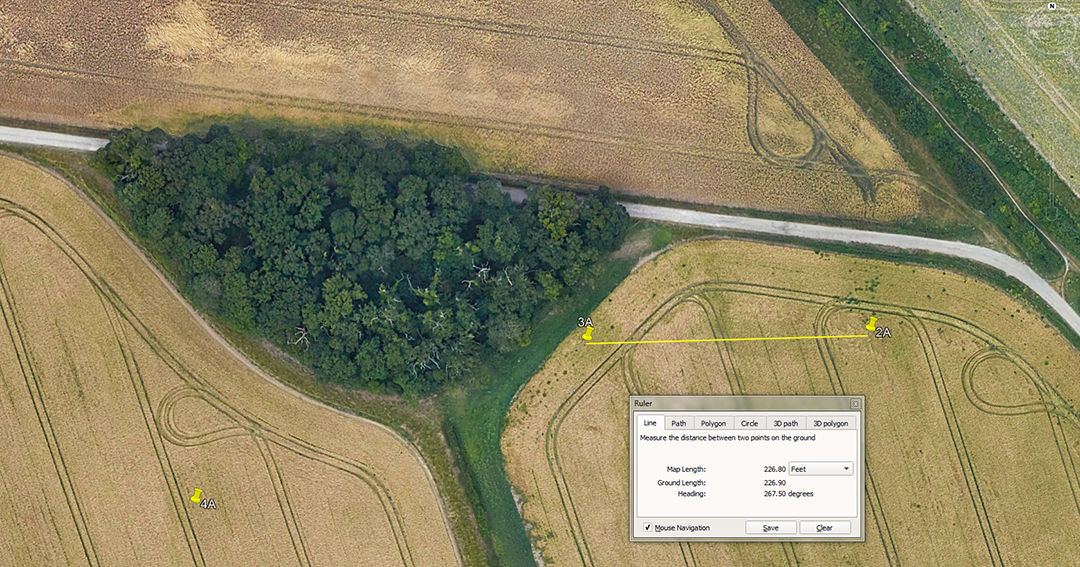
The distance is 226.8-feet and the angle is 267.5-degrees (return angle = 87.5-degrees).
The merits of 225-feet, 230.4-feet would also have been taught.
A mathematical progression based upon 226.8 goes:
226.8, 453.6, 680.4, 9072, 1134, 1360.8, 1587.6, 1814.4, 2041.2, 2268, 2494.8, 2721.6 ...3402, 3628.8 ... 5443.2, 5670 ... 6804, etc.
The sum of 3 sides of the Great Pyramid @ 756-feet per side = 2268-feet, which equates to 22.5 seconds of equatorial arc @100.8-feet per second.
In the above mathematical progression 453.6-feet represents the vertical height of the Great Pyramid to the top of its flat altar floor. It had an observatory and surveying platform atop it and that's why masonic depictions of the top section of the pyramid show an eye with a symbolic capstone floating above it, as seen on the USA dollar bill.

The Great Pyramid, in all history, has never been recorded as a full pyramid with a pointed top, but is a truncated pyramid with an altar floor atop it that sat at 453.6-feet of vertical height, which equates to 264 of the Egyptian Royal cubit of 20.61818182". The formula for generating this cubit is to take the 756-feet length of the pyramid's base, convert it to inches (9072") then divide by 440 = 20.61818182-inches. The 453.6-feet height is also 4.5 seconds of equatorial arc @ 100.8-feet per second.
In the above mathematical progression is the value 1134 (half of 2268). The Greek historian, Herodotus asked Egyptian priests how long the Great Pyramid was and was told 800-feet. We know it is 756 English feet of 12-inches, so the foot the Egyptian priests were talking about would have been 11.34-inches. The Station Stones rectangle at Stonehenge measures 264-feet long by 113.4-feet wide. The sum of 264-feet is 1/20th of a mile of 5280-feet.
The 113.4-feet relates in a dynamic way to the long enduring lunar nutation cycle, as it moves from lunar major standstill-to lunar minor standstill, then back to lunar major standstill. This takes 6798.36-days (18.613-years), but the number shown is not factorable or able to be broken down fluidly into fractions (halved, quartered, etc., into usable increments). Because of this, ancient astronomer-mathematicians called this cycle 6804-days and encoded this value into their edifices or overland alignment structures. The value chosen for reading the cycle was so close to the real duration that it meant less than a minute of time in error for a lunar month. Therefore 6804-days ÷ 1134 = 6. This provided a means of reading the positions of the moon throughout the cycle in terms of months, weeks, days and hours on ancient parapegma plaques like the lunisolar Calendar of Coligny.
The southern circle at Avebury Henge has a design diameter of 340.2-feet and the same holds true of the standing stone circle at the Ring 'o Brodgar, Orkney Islands, Scotland. The 3402 value represents the half cycle within the 6804-day lunar nutation cycle. It is also encoded into the "inch" value reading for 1 circumnavigation of the Khafre Pyramid of Egypt (708.75-feet per side or 2835-feet for a full circuit) The 2835-feet around the Khafre Pyramid = 34020-inches.
The return degree angle for the above shaft-station to shaft-station is 87.5-degrees. A mathematical progression based on this goes:
87.5, 175, 262.5, 350, 437.5, 525, 612.5, 700, 787.5, 875, 962.5, 1050, 1137.5, 1225, 1312.5, 1400, 1487.5, 1575 ... 2100 ... 2800 ... 3150 ... 3675 ... 4725 ... 5250 ... 6300 ... 7087.5, etc.
In ancient society, the astronomer savants amongst the cousin civilisations worked to a very precise lunisolar calendar system called the Sabbatical Calendar. The evidence found on Megalithic-Neolithic sites would suggest that knowledge of that system extends back thousands of years. However, concurrent to the savants staying precisely abreast of the daily journeys of the sun and moon, the farmers needed a simpler system, so we know that some societies worked to a year composed of 13-months of 28-days each (364-days). This was allowed to run for 7-solar years, accruing an error of 1.25-days per year, culminating in 8.75-days of error. At the end of the Sabbatical Year a 9-day festival would commence and intercalary days would be inserted to correct the shortfall error, before the new calendar count got underway.
There are some groups, like the Hebrews, who had a double sabbath day once a year, bringing the total days to 365 and accruing only 1.75-days of error in 7-years. Their intercalary festival, at the end of the Sabbatical Year, would last only 2-days.
Other important values that occur in this string are: 525-feet (the length of a Greek short stadia and 1/10th of a Greek mile), 1050-feet (a Hebrew Reed was 10.5-feet or 10 Greek feet), 5250 (Greek mile), 6300-feet (the long stadia measurement was 630-feet) The distance from the centre of the Octagon' circle (an ancient, huge, geometric earth embankment complex) of Newark, Ohio), to the centre of the equally huge "Great Circle" (Newark showgrounds) earth embankment circle is 6300 feet or 10 long stadia.
The progression advances to provide the number 7087.5. As stated the Khafre Pyramid is 15/16ths the side length of the Great Pyramid in original architectural dimensions, or 708.75-feet and, in days, that would be 2 lunar years.

A line of 7087.5-feet (1.35-Greek miles or 11.25 long stadia) extends from the tall obelisk position at Avebury Henge's southern circle to the entrance of West Kennet Long Barrow. The return angle from the doorway to the obelisk position at Avebury Henge is 354.375-degrees (half of 708.75 and also, in days, the length of a lunar year).

The alignment starts at the plinth that marks where the former high obelisk stood at the centre of Avebury Henge's southern circle, then passes centrally through the southern gate en-route to the entryway line of obelisks at West Kennet Longbarrow. The actual epicentre of Avebury Henge, the position where students would once have congregated to memorise stellar rises and sets occuring atop the outlying, circuiting embankment, is now covered by roading or a building.
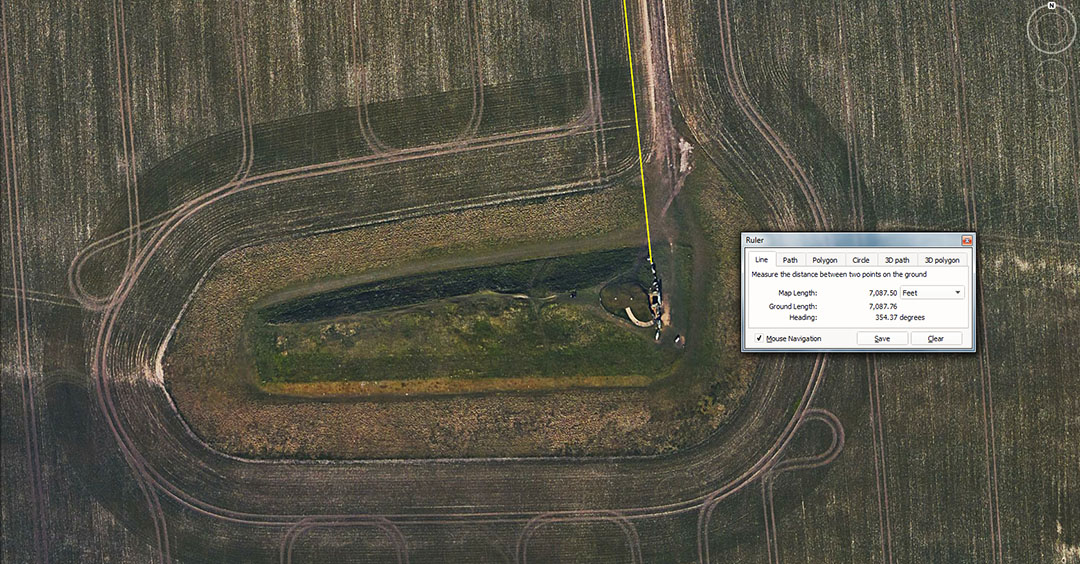
The 7087.5-feet line resolves to the entryway obelisks, which are in a line angled at 354.375-degrees back to the formerly giant obelisk at Avebury Henge ... that could be seen for miles around the henge.
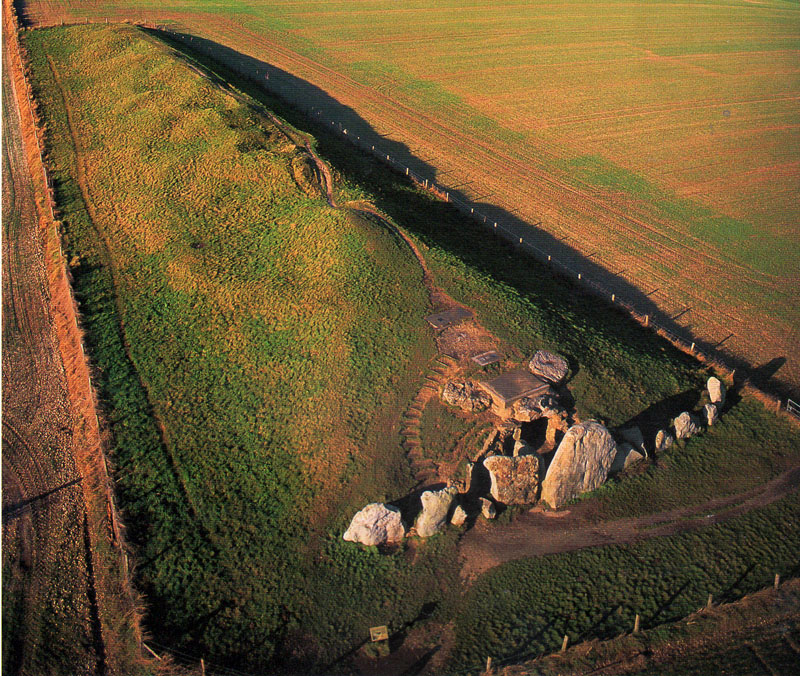
The entryway obelisk line at West Kennet Longbarrow.
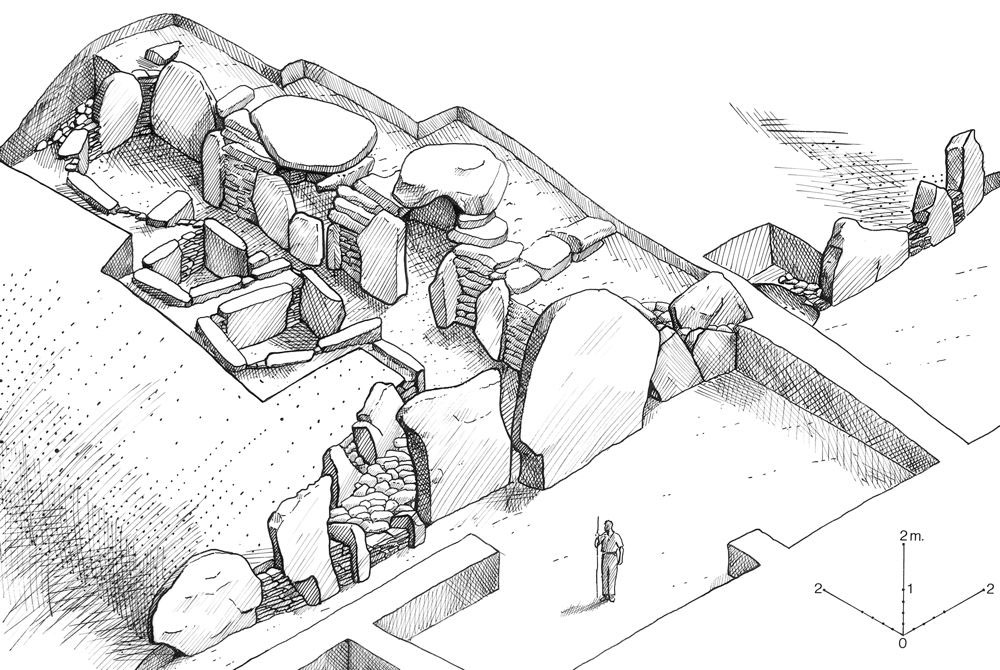
Although this laboriously built, chambered mound (roof removed in this schematic to show the internal structure) is considered by our archaeologists to have been conceived as a tomb for the dead, it obviously was built as a shelter or dormitory for groups of students engaged in orienteering-navigation quests. Composed as it is of about 5 large rooms off a central corridor, it was assuredly built for the living and not the dead. The fact that late era people, after the open-air university fell into decline, found it a convenient place to stow some cadavers, rather than dig graves, is irrelevant to the original purpose.
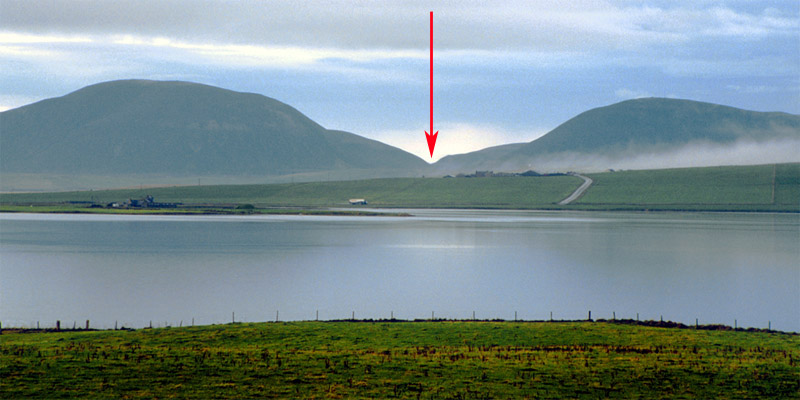
The "V" at Hoy Island, as seen from the centre of the Ring 'o Brodgar in the Orkney Islands. The "V" acted as as a permanent surveying fix position or benchmark and as one of two major geological features that determined where the precise centre of Ring o' Brodgar had to be. The return angle from the trough of the "V" between Ward Hill (left) and Cuilags Hill (right) was 35.4375-degrees return (35 & 7/16ths ... or 1/10th of a lunar year in days). The winter solstice sunset afterglow or "last glint" at that high northern lattitude is in the "V" trough.
The "V" also determined exactly where Maes Howe chambered cairn was placed, with its doorway sitting 8 ancient Scottish miles (of 5940') or 9 English miles (of 5280') from the trough of the "V" on Hoy @ 224-degrees azimuth or 44-degrees return. From this very exact fix point on Hoy, ancient surveyors, setting up their manual theodolites atop Maes Howe chambered cairn, could use the "V" fix point (at precisely 224-degrees azimuth) for setting their 360-degree calibrated disc. After that they could achieve perfect readings onto any other targets around the horizon. Across the expansive, Orkney, Open-air-university there were numerous chambered cairns or mounds, similar to West Kennet Longbarrow in England, where students of navigation, out-and-about on orienteering quests, could shelter from the intense cold of northern Scotland. (Photo courtesy of: http://www.mrtattieheid.com/index.htm).